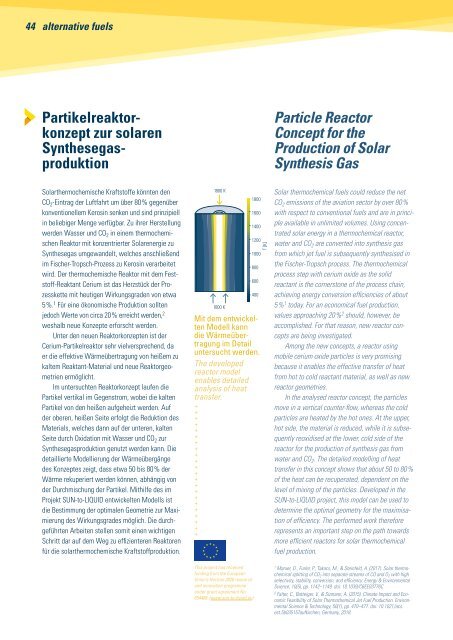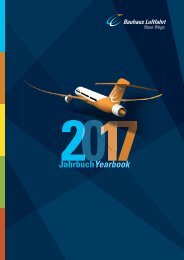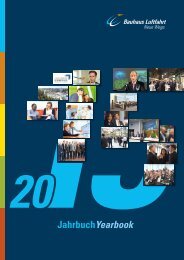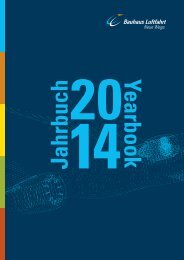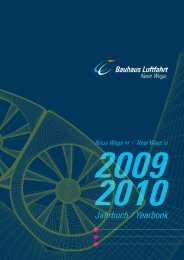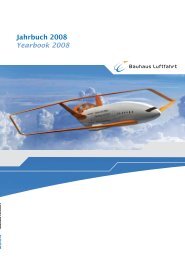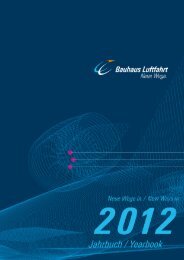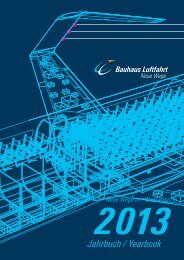Bauhaus Luftfahrt Jahrbuch 2018
Create successful ePaper yourself
Turn your PDF publications into a flip-book with our unique Google optimized e-Paper software.
44 alternative fuels<br />
Partikelreaktorkonzept<br />
zur solaren<br />
Synthesegasproduktion<br />
Particle Reactor<br />
Concept for the<br />
Production of Solar<br />
Synthesis Gas<br />
Solarthermochemische Kraftstoffe könnten den<br />
CO 2 -Eintrag der <strong>Luftfahrt</strong> um über 80 % gegenüber<br />
konventionellem Kerosin senken und sind prinzipiell<br />
in beliebiger Menge verfügbar. Zu ihrer Herstellung<br />
werden Wasser und CO 2 in einem thermochemischen<br />
Reaktor mit konzentrierter Solarenergie zu<br />
Synthesegas umgewandelt, welches anschließend<br />
im Fischer-Tropsch-Prozess zu Kerosin verarbeitet<br />
wird. Der thermochemische Reaktor mit dem Feststoff-Reaktant<br />
Cerium ist das Herzstück der Prozesskette<br />
mit heutigen Wirkungsgraden von etwa<br />
5 %. 1 Für eine ökonomische Produktion sollten<br />
jedoch Werte von circa 20 % erreicht werden, 2<br />
weshalb neue Konzepte erforscht werden.<br />
Unter den neuen Reaktorkonzepten ist der<br />
Cerium-Partikelreaktor sehr vielversprechend, da<br />
er die effektive Wärmeübertragung von heißem zu<br />
kaltem Reaktant-Material und neue Reaktorgeometrien<br />
ermöglicht.<br />
Im untersuchten Reaktorkonzept laufen die<br />
Partikel vertikal im Gegenstrom, wobei die kalten<br />
Partikel von den heißen aufgeheizt werden. Auf<br />
der oberen, heißen Seite erfolgt die Reduktion des<br />
Materials, welches dann auf der unteren, kalten<br />
Seite durch Oxidation mit Wasser und CO 2 zur<br />
Synthesegasproduktion genutzt werden kann. Die<br />
detaillierte Modellierung der Wärmeübergänge<br />
des Konzeptes zeigt, dass etwa 50 bis 80 % der<br />
Wärme rekuperiert werden können, abhängig von<br />
der Durchmischung der Partikel. Mithilfe des im<br />
Projekt SUN-to-LIQUID entwickelten Modells ist<br />
die Bestimmung der optimalen Geometrie zur Maximierung<br />
des Wirkungsgrades möglich. Die durchgeführten<br />
Arbeiten stellen somit einen wichtigen<br />
Schritt dar auf dem Weg zu effizienteren Reaktoren<br />
für die solarthermochemische Kraftstoffproduktion.<br />
+ + + + + + + + + + + + + + + + + + + + + + + + + + + + + + + + + + + + + +<br />
1800 K<br />
1000 K<br />
Mit dem entwickelten<br />
Modell kann<br />
die Wärmeübertragung<br />
im Detail<br />
untersucht werden.<br />
The developed<br />
reactor model<br />
enables detailed<br />
analysis of heat<br />
transfer.<br />
This project has received<br />
funding from the European<br />
Union’s Horizon 2020 research<br />
and innovation programme<br />
under grant agreement No.<br />
654408. (www.sun-to-liquid.eu)<br />
1800<br />
1600<br />
1400<br />
1200<br />
1000<br />
800<br />
600<br />
400<br />
T [K]<br />
Solar thermochemical fuels could reduce the net<br />
CO 2 emissions of the aviation sector by over 80 %<br />
with respect to conventional fuels and are in principle<br />
available in unlimited volumes. Using concentrated<br />
solar energy in a thermochemical reactor,<br />
water and CO 2 are converted into synthesis gas<br />
from which jet fuel is subsequently synthesised in<br />
the Fischer-Tropsch process. The thermochemical<br />
process step with cerium oxide as the solid<br />
reactant is the cornerstone of the process chain,<br />
achieving energy conversion efficiencies of about<br />
5 % 1 today. For an economical fuel production,<br />
values approaching 20 % 2 should, however, be<br />
accomplished. For that reason, new reactor concepts<br />
are being investigated.<br />
Among the new concepts, a reactor using<br />
mobile cerium oxide particles is very promising<br />
because it enables the effective transfer of heat<br />
from hot to cold reactant material, as well as new<br />
reactor geometries.<br />
In the analysed reactor concept, the particles<br />
move in a vertical counter-flow, whereas the cold<br />
particles are heated by the hot ones. At the upper,<br />
hot side, the material is reduced, while it is subsequently<br />
reoxidised at the lower, cold side of the<br />
reactor for the production of synthesis gas from<br />
water and CO 2 . The detailed modelling of heat<br />
transfer in this concept shows that about 50 to 80 %<br />
of the heat can be recuperated, dependent on the<br />
level of mixing of the particles. Developed in the<br />
SUN-to-LIQUID project, this model can be used to<br />
determine the optimal geometry for the maximisation<br />
of efficiency. The performed work therefore<br />
represents an important step on the path towards<br />
more efficient reactors for solar thermochemical<br />
fuel production.<br />
1<br />
Marxer, D., Furler, P., Takacs, M., & Steinfeld, A. (2017). Solar thermochemical<br />
splitting of CO 2 into separate streams of CO and O 2 with high<br />
selectivity, stability, conversion, and efficiency. Energy & Environmental<br />
Science, 10(5), pp. 1142–1149. doi: 10.1039/C6EE03776C<br />
2<br />
Falter, C., Batteiger, V., & Sizmann, A. (2015). Climate Impact and Economic<br />
Feasibility of Solar Thermochemical Jet Fuel Production. Environmental<br />
Science & Technology, 50(1), pp. 470–477. doi: 10.1021/acs.<br />
est.5b03515Taufkirchen, Germany, <strong>2018</strong>.


